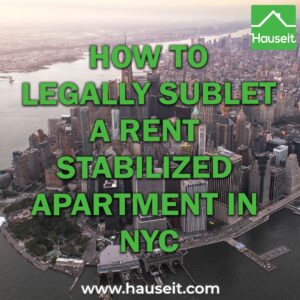It’s legal for you to sublet your rent stabilized apartment in NYC provided you adhere to specific rules and procedures. There is a limit to how often you can sublet, and you’re prohibited from charging the subletter more than what you pay in rent.
The rent stabilized apartment must be maintained as your primary residence throughout the term of the sublet. You’re also required to follow a specific procedure to obtain subletting permission from your landlord.
Click on the sections below to learn more. Thinking of buying in NYC? Estimate your buyer closing costs in NYC using Hauseit’s Buyer Closing Cost Calculator, and consider requesting a Hauseit Buyer Closing Credit to save money on your purchase.
There is a limit to how often you can sublet
You may only sublet your rent stabilized New York City apartment for no more than two years out of the four-year period preceding the expiration date of the proposed sublet.
This is outlined in Rent Stabilization Code § 2525.6(c):
This provision is quite similar to sublet restrictions for co-ops in that it’s designed to prevent you from perpetually renting the apartment without actually living there for a period of time.
If you sublet your rent stabilized apartment while having another primary residence, your landlord may seek to terminate your tenancy in court.
By extension, you may not buy a NYC apartment as your primary residence and then sublet your rent stabilized apartment.
A Full Service Listing for 1%
Sell your home with a traditional full service listing for just one percent commission.
You may only charge the subtenant more than what you pay if the property is offered furnished. However, you are not allowed to charge a premium in excess of 10% of the rent you pay.
If you overcharge your subtenant, she or he may be entitled to treble damages. The tenant can file a complaint by submitting a form called “Tenant’s Complaint of Rent and/or Other Specific Overcharges in a Rent Stabilized Apartment” to NYS Homes and Community Renewal (HCR), the state agency which administers the rent laws.
Per the NYC Rent Guidelines Board, “If HCR finds that the prime tenant has deliberately overcharged you, then they may be required to refund to you three times the overcharge.”
You must follow a specific procedure to legally sublet
In order to legally sublet your rent stabilized NYC apartment, you must first share a bunch of required information with the landlord via certified mail, return receipt requested. The following items must be submitted to the landlord:
-
the term of the sublease
-
the name of the proposed sublessee
-
the business and permanent home address of the proposed sublessee
-
the tenant’s reason for subletting
-
the tenant’s address for the term of the sublease
-
the written consent of any cotenant or guarantor of the lease
-
a copy of the proposed sublease, to which a copy of the tenant’s lease shall be attached if available, acknowledged by the tenant and proposed subtenant as being a true copy of such sublease.







